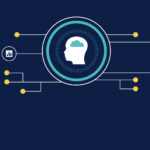The top 10 technology trends for 2018
Companies cannot afford to turn their backs on technological progress and technology trends. “Technology will be embedded in everything in the digital business of the future,” says the research firm Gartner, in its 'Top 10 Strategic Technology Trends for 2018'.
Gartner predicts that the trends on its list will mark the course of the next decade. They all form part of something the research firm terms the intelligent digital mesh, “an entwining of people, devices, content and services”.
Those three words – intelligent, digital and mesh – are also the categories into which the research firm divides these essential services. Among them are autonomous robotics, the applications of the Internet of Things and blockchain-based solutions.

Artificial Intelligence as foundation
Artificial Intelligence (AI) will play an increasingly relevant role in the daily management of businesses. By 2025, AI will become the “essential” tool both for redefining customer experience and for reinventing a broad variety of business models.
However, Gartner makes a key distinction between two types of AI: General AI, understood as a system capable of performing any task humans do and of learning as they do. This type of artificial intelligence “should be left for to researchers and science fiction writers,” says David Cearley, vice president of Gartner. The second variety, Narrow AI, is capable of learning how to perform very specific tasks, and perform them extremely well, such as understanding human language or driving a car within a controlled environment.
Narrow AI, powered by highly specialized machine learning algorithms, promises the best results for businesses. Gartner recommends that companies focus on Narrow AI applications in the next few years.
BBVA has already anticipated this trend. Four years ago, the bank created BBVA Data & Analytics, a team of experts that uses ‘Big Data’ in combination with advanced machine learning techniques, for improving specific internal processes, creating new automated services and developing more personalized products for customers. One example of this is BBVA Bconomy, a functionality that uses artificial intelligence to measure customers’ financial health, based on their data, and offers them personalized saving strategies.
Applications and intelligent analysis
The Gartner report also notes that, in the future, virtually all apps and services will utilize some sort of AI. This will result in the development of smart apps that will act as unobtrusive intelligent intermediaries in the relationship between people and systems. These apps have the potential to transform the nature of work in the future, by creating an intermediary between people and systems, as seen in virtual customer assistants.
The report sets out the need to “explore intelligent apps as a way of augmenting human activity, and not simply as a way of replacing people.” Also, it points to augmented analytics as a “particularly strategic growing area, which uses machine learning for automating data preparation, insight discovery and insight sharing for a broad range of businesses”. Using AI to add “business value” will be the great challenge facing companies, Cearly says.
In the financial sector, the inclusion of automatic intelligent functions allows decisions to be made based on the best available information. A good example of this is the award-winning RedeX program – a program developed by BBVA Data & Analytics, recently awarded by The Banker (a publication of the Financial Times Group) - which improved the risk assessment processes for new and existing customer loan applications by taking into account a broad range of data, including bank transfers, official gazettes, and operations with other institutions – without having to request additional information.
Smart objects that talk to each other
Driverless cars, robots or unmanned aircraft - everything will be connected in the future and, with the arrival of 5G networks, the Internet of things will develop to its fullest potential. This trend of connecting devices, allowing them to “talk” to each other, will enable more natural interaction with the environment, driving a paradigm shift in human-machine interaction, one that is essential for the development of sustainable businesses.
As this trend proliferates, a network of collaborative intelligent things will be created, where multiple devices will work together (cars, traffic lights, roads, smartphones), either independently or with human input.
A digital twin to create value
A digital twin is a virtual representation of a real-world entity or system. It is akin to the digital reflection of the objects connected to the Internet of Things, which contain information about their status in the real world. These digital avatars can respond to changes in the environment, improve processes and add value. Considering the volume of connected devices there will be in the world by 2020 (some 21 billion according to Gartner), managing them properly could lead to potential savings of billions of dollars in maintenance, repair and operation while optimizing asset performance.
Digital twins will allow data analysis and monitoring of all types of systems to prevent problems, avoid down times, develop new opportunities and even plan for the future through simulations.

A digital twin is a virtual model of a process, product or service.
“Over time, digital representations of virtually every aspect of our world will be connected dynamically with their real-world counterparts and with one another and infused with AI-based capabilities to enable advanced simulation, operation and analysis,” says Gartner vice-president David Cearly.
The cloud is not alone: the era of 'edge computing’ is here
Gartner defines ‘Edge computing’ as “a computing model in which information processing and content collection take place near the sources of this information.” In other words, instead of processing these data in the cloud, each device connected to the network would play its own role in processing information. This approach seeks to reduce latency (delays due to data transfers) and network saturation.
The edge computing adoption trend will be driven by the increasing use of mobile devices, especially the consumption of video, virtual and augmented reality, as well as the massive deployment of sensors as part of the IoT. Analysts expect a dramatic surge in demand in 2018, although it is still not clear what the supporting infrastructure will look like.
What the report does indicate is that cloud and edge computing will be complementary. Edge computing refers to a new topology that places computing processes on the “edge” of the network, closer to connected users or objects. The cloud, on the other hand, ”is a system where technology services are delivered using Internet technologies.”
Chatbots hit a turning point
Chatbots will bring on the most significant change in human-machine interaction. Will we ever be able to interact with a machine just as we do with another human being? Here’s where voice assistants like Siri or Cortana come in. Will they be able to talk to customers in 2018? In other words, will they be able to understand and anticipate what customers mean?
Cearley suggests that “conversation platforms have reached a turning point in terms of understanding the user's basic language and intent, but there is still work to be done.” A trend that according to Garner, will extend to other uses, mainly professional, that will allow prompting operations and transactions without the need to gather the information previously.
BBVA’s Garanti in Turkey has developed MIA (Mobile Interactive Assistant), a chatbot that uses plain language to answer user questions and carry out actions such as transfers or buying and selling foreign currency… all voice-enabled. The assistant was recognized this year in the European Financial Management Association awards, where it was hailed as one of the most relevant innovations.
BBVA is also integrating its financial services in the main social networks through virtual assistants. For this purpose, it has developed a 'Chatbot’ an AI-based banking bot that “talks” to users and allows for gathering personal information about an account through Facebook and Telegram. Today, this bot also enables users to transfer money through messaging apps. iPhone users can use their iOS voice assistant, Siri, to perform these transactions.
Mixed and immersive experiences
Determining the areas in which real life virtual reality (VR) and augmented reality (AR) can be used and applied is next year’s challenge for businesses. So far, the market is still highly fragmented. According to Gartner, the arrival of ‘mixed reality,’ combined with conversational platforms, can help create a new generation of “immersive and invisible" experiences, where users interact with both digital and real objects, while maintaining a presence in the physical world.

Facebook’s VR goggles, Oculus Go, will launch in early 2018.
This leap will be essential to changing the public perception of these devices as exclusively linked to entertainment. According to Gartner, over the next five years, these new mixed reality spaces will make it possible to adapt this technology to specific work environments such as training. Also, with the release of Google’s and Apple’s VR and AR platforms, the battle for smartphone-based AR and MR is expected to heat up in 2018.
'Blockchain' integrated in business
'Blockchain’ is a distributed ledger technology originally developed to support crypto-currency transactions. Today, the technology is expected to transform, at some point, industries such as transport, logistics, the food industry and the financial sector.
In two to three years’ time, according to Gartner, ‘blockchain’ will reach the level of maturity required to develop actual apps and solutions, although the research firm also warns about the need to create a regulatory framework that covers the exploration of this new technology. Gartner notes some of the challenges that companies ready to invest in these technologies will have to face, and advises them to “Identify the integration points with existing infrastructures, and monitor the platform evolution and maturation.”
BBVA began working with ‘blockchain’ four years ago and is currently a member of three consortiums that explore the technology's potential to create common standards and build efficient platforms: R3, Hyperledger and EEA.
Recently, BBVA carried out the first blockchain-based international trade transaction between Europe and Latin America. In a pilot test performed in partnership with Wave, BBVA managed to issue, verify and authorize an import-export order in 2.5 hours. The process currently takes 7 to 10 days.
Over the last year, BBVA has been collaborating with R3 in several projects such as the development of a platform to redesign trade finance operations through smart contracts and the creation of a blockchain-based identity management system. Also, BBVA and BBVA Bancomer are taking part in a pilot project with DLT technologies for currency operations; in April, 2017, BBVA carried out the first real international money transfer test, based on Ripple’s DLT technology.
Event-based decisions
The convergence of the Internet of Things with advanced analytics in digital ecosystems has spawned a new term: “event thinking.” It refers to automatic decision making processes within a business, triggered by a series of pre-established events. In other words, given a situation “x” in a specific context, systems must be capable of activating "y."
According to Garner, in 2020, 80% of digital businesses and solutions will need to support this type of mechanisms to adopt real-time decisions based on the data collected about their environment.

Event thinking means understanding that businesses must now operate dynamically and in real time.
Real-time risk management
As digital ecosystems become more complex and sophisticated, so do security risks. Gartner argues that the solution to address a context that is growing increasingly concerned is to opt for a model called CARTA (Continuous Adaptive Risk and Trust Assessment), which enables taking real-time decisions to adapt to changes in risk levels and provides immediate, flexible and customized answers. According to Gartner, this approach “implies embracing a proactive people-centric approach to security, empowering developers to take responsibility for security measures.”
This strategy includes techniques such as “honeypots,” tools that intended to deceive attackers by setting traps that lure them to the system and then neutralize them. Gartner predicts a promising future for this new approach (according to estimates, in 2018 10% of companies will already use deception technologies), which allows detecting threats that would go unnoticed by regular cyber defense systems.

In 2018 we will need to improve cybersecurity systems to face growing threats.